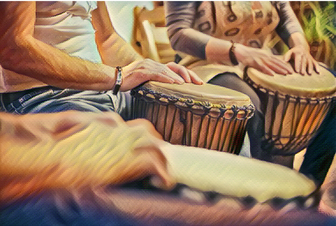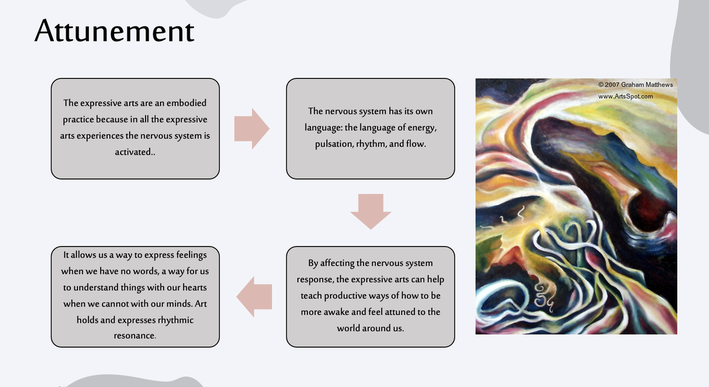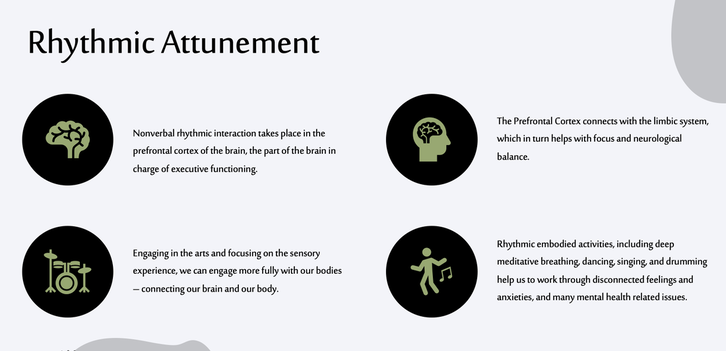Music & Guided ImageryThe therapeutic use of music/sound can be used to create an embodied experience that encourages healing growth, and overall well-being. It can also be used to help process difficult feelings when words alone cannot reach them. The links and articles on this page provide a broad overview of using Music and Guided Imagery in Counseling. There are many more awesome websites and articles that are not listed.
|
Self-Regulation
Expressive arts approaches can support self-regulation by becoming more attuned with the body (embodied), allowing us to be more connected. It allows us a way to express feelings when we have no words, allowing us to explore these feelings before we are able touse our words.
Breathing techniques helps to teach coping skills to help manage everyday life situations. The alternate nostril breathing technique helps to lower heart rate (Cronkleton, 2022).
Breathing techniques helps to teach coping skills to help manage everyday life situations. The alternate nostril breathing technique helps to lower heart rate (Cronkleton, 2022).
Attunement - Embodied Practices
MUSIC THERAPY AND GUIDED IMAGERY LINKS
- American Music Therapy Association
- Appalachian State University Hayes School of Music
- Atlantis Institute for Consciousness and Music
- Canadian Association of Music Therapists
- IMAGEing: European GIM Trainings (Bonny Method)
- Inner Journey with GIM: Canada
- Institut fur Imagination und Therapy (IMIT)
- The Integrative GIM Training Programme: UK
- KAMI (Korean Association for Music an Imagery)
- Leslie Bunt
- Music Medicine Institute An Affiliate of St. Joseph’s/Candler Health System
- Music and Imagery Association of Australia
- The Danish Bonny Method GIM Institute
- The Temple University Archives for Guided Imagery and Music
- Therapeutic Arts Institute
- http://www.childdrama.com/guided-imagery.html (guided imagery)
- Guided Imagery: the 5 senses
- Yogaalliance.org
- https://www.youtube.com/watch?v=ijWKxrw0izg&feature=youtu.be (Trauma Sensitive Yoga – Animation)
- https://www.youtube.com/watch?v=bYvdhbhCxxM (Bessel Van der Kolk: Overcome trauma with yoga)
ARTICLES
- Cronkleton, E. (2022, March 16). Alternate nostril breathing: Benefits, how to, and more. Healthline.
- Emerson, D., & Hopper, E. (2012). Overcoming trauma through yoga: Reclaiming your body. North Atlantic Books.
- Germer, C. K. (2013). Mindfulness: What is it? What does it matter?.
- Gleadhill, L., & Ferris, K. (2010). A theoretical music therapy framework for working with people with dissociative identity disorder. Australian Journal of Music Therapy, 21, 42-55.
- Krout, R. E. (2005). Applications of music therapist-composed songs in creating participant connections and facilitating goals and rituals during one-time bereavement support groups and programs. Music Therapy Perspectives, 23(2), 118-128.
- Ladany, N., Hill, C. E., Thompson, B. J., & O'Brien, K. M. (2004). Therapist perspectives on using silence in therapy: A qualitative study. Counselling and Psychotheraphy Research, 4(1), 80-89.
- Lehmann, O. V., Kardum, G., & Klempe, S. H. (2019). The search for inner silence as a source for Eudemonia. British Journal of Guidance & Counselling, 47(2), 180-189.
- MacIntosh, H. B. (2003). Sounds of healing: Music in group work with survivors of sexual abuse. The Arts in Psychotherapy, 30(1), 17-23.
- Malchiodi, C. A. (2020). Trauma and expressive arts therapy: Brain, body, and imagination in the healing process. The Guilford Press.
- Mungas, R., & Silverman, M. J. (2014). Immediate effects of group-based wellness drumming on affective states in university students. The Arts in Psychotherapy, 41(3), 287-292.
- Nguyen-Feng, V. N., Hodgdon, H., Emerson, D., Silverberg, R., & Clark, C. J. (2020). Moderators of treatment efficacy in a randomized controlled trial of trauma-sensitive yoga as an adjunctive treatment for posttraumatic stress disorder. Psychological trauma: theory, research, practice, and policy, 12(8), 836.
- Nicotera, N., & Connolly, M. M. (2020). The influence of trauma-informed yoga (TIY) on emotion regulation and skilled awareness in sexual assault survivors. International journal of yoga therapy, 30(1), 19-31.
- Richards, A. V. (2017). A qualitative study of group therapy incorporating rap music with inmates.
- Prendiville, S. (2021). Sensory play therapy. American Psychological Association.
- Shienko, L. (2021). Integrating Mindfulness Into Adlerian Therapy as a Medical Alternative Treatment for Depression. The Journal of Individual Psychology, 77(4), 427-445.Lilya Shienko
- Stephens, T., Braithwaite, R. L., & Taylor, S. E. (1998). Model for using hip-hop music for small group HIV/AIDS prevention counseling with African American adolescents and young adults. Patient Education and Counseling, 35(2), 127-137.
- Teggelove, K., Thompson, G., & Tamplin, J. (2019). Supporting positive parenting practices within a community‐based music therapy group program: Pilot study findings. Journal of community psychology, 47(4), 712-726.
- Veach, L. J., & Gladding, S. T. (2006). Using creative group techniques in high schools. The Journal for Specialists in Group Work, 32(1), 71-81.
Visualizing (as in Guided Imagery): Example
The same portions of the brain are activated when visualizing as when experiencing it in actuality. People that are not physically able to dance can visualize the experience as if they are actually dancing. Athletes often use visualization to “act as if” the action is occurring, enhancing their performance.
Body Work and Imagery: Imagine the YogaTree pose. It teaches clients to let go of preconceived notions of what “should” be (or look like) and FEEL what it is like to: be rooted (secure) and have the ability to sway (flexible and resilient).
The same portions of the brain are activated when visualizing as when experiencing it in actuality. People that are not physically able to dance can visualize the experience as if they are actually dancing. Athletes often use visualization to “act as if” the action is occurring, enhancing their performance.
Body Work and Imagery: Imagine the YogaTree pose. It teaches clients to let go of preconceived notions of what “should” be (or look like) and FEEL what it is like to: be rooted (secure) and have the ability to sway (flexible and resilient).





